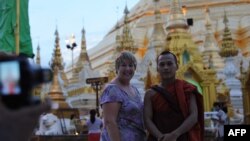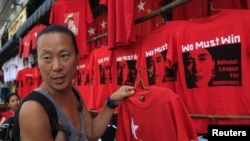BANGKOK — Tourism is the latest indicator of change in Burma, with tourist and business arrivals up more than 30 percent. In the first seven months of this year there were about 300,000 arrivals, nearly the same number as for all of 2011.
Visitors from Thailand represented the largest group from Asia, followed by Japan, China and South Korea. European nationals accounted for nearly a quarter of Burma's visitors.
By 2014, when Burma plans to host the annual meetings of the Association of South East Asian Nations, arrivals are forecast to climb to nearly a million.
There are presently 25,000 hotel rooms across Burma - also known as Myanmar - with 8,000 rooms in the commercial capital of Rangoon.
But the rapid growth has led to bottlenecks for tour operators and increasing competition for rooms between tourists and business travelers.
Luzi Matzig, a veteran of the travel industry and chief executive of the Bangkok-based Asian Trails, says the rapid expansion of tourism in Burma has been unprecedented.
“We never had any country with such a rapid growth - an explosion of growth," said Matzig. "Never happen. Our problem now in number of passengers - we can hardly grow because there simply isn’t the capacity there in hotel rooms or transport.”
Matzig says there are complaints by tour operators of escalating hotel room rates and an inability to secure advance contracts for blocks of rooms.
The easing of long standing economic sanctions against Burma due to an improved human rights record has brought a flood of business travelers, he adds. Some companies are block booking rooms that would normally have been occupied by tourists.
Burma’s deputy minister for hotels and tourism, Htay Aung, says while the growth is welcomed it has created new challenges, especially a need to upgrade human resources and infrastructure.
“We need to upgrade the standards, standards of services - very important," Aung said. "The second thing is transportation - domestic transportation - and also upgrade of the hotels, the existing hotels. We have to upgrade the existing tourist sites in the same way, also open up the new tourist sites.”
Burma is now planning for a new international airport close to Rangoon as well as increasing the number of rooms in the city by converting apartments to hotels, adding a further 500 rooms this year.
The Asian Development Bank is preparing a tourism master plan for Burma. Regional air carriers are also increasing services.
ADB economist, Alfredo Perdiguero, says infrastructure and human development are key constraints on the economy.
“The transport, there’s still a lot of obstacles both in the ports and a lot of obstacles across borders, Perdiguero said. "If you look at the capacities you need to have employees. We have certain capacities but due to the deterioration of the vocational training and the university system - both in Myanmar and within the [last] 20 to 30 years - they don’t have that.”
The government says its tourism policy aims to help ease poverty and empower women, with a “steady” growth of arrivals to benefit local communities and the long-term development of Burma.
Visitors from Thailand represented the largest group from Asia, followed by Japan, China and South Korea. European nationals accounted for nearly a quarter of Burma's visitors.
By 2014, when Burma plans to host the annual meetings of the Association of South East Asian Nations, arrivals are forecast to climb to nearly a million.
There are presently 25,000 hotel rooms across Burma - also known as Myanmar - with 8,000 rooms in the commercial capital of Rangoon.
But the rapid growth has led to bottlenecks for tour operators and increasing competition for rooms between tourists and business travelers.
Luzi Matzig, a veteran of the travel industry and chief executive of the Bangkok-based Asian Trails, says the rapid expansion of tourism in Burma has been unprecedented.
“We never had any country with such a rapid growth - an explosion of growth," said Matzig. "Never happen. Our problem now in number of passengers - we can hardly grow because there simply isn’t the capacity there in hotel rooms or transport.”
Matzig says there are complaints by tour operators of escalating hotel room rates and an inability to secure advance contracts for blocks of rooms.
The easing of long standing economic sanctions against Burma due to an improved human rights record has brought a flood of business travelers, he adds. Some companies are block booking rooms that would normally have been occupied by tourists.
Burma’s deputy minister for hotels and tourism, Htay Aung, says while the growth is welcomed it has created new challenges, especially a need to upgrade human resources and infrastructure.
“We need to upgrade the standards, standards of services - very important," Aung said. "The second thing is transportation - domestic transportation - and also upgrade of the hotels, the existing hotels. We have to upgrade the existing tourist sites in the same way, also open up the new tourist sites.”
Burma is now planning for a new international airport close to Rangoon as well as increasing the number of rooms in the city by converting apartments to hotels, adding a further 500 rooms this year.
The Asian Development Bank is preparing a tourism master plan for Burma. Regional air carriers are also increasing services.
ADB economist, Alfredo Perdiguero, says infrastructure and human development are key constraints on the economy.
“The transport, there’s still a lot of obstacles both in the ports and a lot of obstacles across borders, Perdiguero said. "If you look at the capacities you need to have employees. We have certain capacities but due to the deterioration of the vocational training and the university system - both in Myanmar and within the [last] 20 to 30 years - they don’t have that.”
The government says its tourism policy aims to help ease poverty and empower women, with a “steady” growth of arrivals to benefit local communities and the long-term development of Burma.






